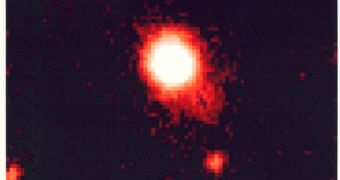A form of cosmic climate change apparently took place in the early Universe, according to the conclusions of a new scientific study on the matter. The temperature of gases billions of years ago began to rise, and continued to do so for a long time – now researchers are wondering why.
Astrophysicists say that the warming effect was significant, and was not limited to just a few degrees. The process took place between the time when the Universe was 1.37 and 3.43 billion years old.
The change was discovered in “relic light” traveling through the Universe, as investigators were attempting to measure the temperature of intergalactic gas. The stuff is mostly made of hydrogen.
This medium was determined to have experienced a sudden, yet steady, rise in temperature a long while back. The current age of the Universe is estimated to be around 13.75 billion years, astronomers say.
Commenting on the new discovery, experts propose that the event was caused by quasars, which are highly-active supermassive black holes located at the cores of very distant galaxies.
In past studies, these objects have been found to emit vast amounts of ultraviolet (UV) radiation, which apparently contributed to the onset of a series of chemical reactions in the intergalactic medium that led to the latter heating up steadily.
“Early in the history of the universe, the vast majority of matter was not in stars or galaxies. Instead, it was spread out in a very thin gas that filled up all of space,” explains Dr. George Becker, who holds an appointment as an astronomer at the University of Cambridge.
“The gas casts a series of shadows on the light given off by quasars, which are extremely distant, bright objects,” the expert says, adding that the light the team looked at in the new study emanated from a quasar located some 10 billion light-years away.
“By analyzing how those shadows block the background light from the quasars, we can infer many of the properties of the absorbing gas, such as where it is, what it's made of, and how hot it is,” he adds.
According to the research team, each time that light passed through an intergalactic gas cloud, it caught on what experts call an imprint, a set of properties that the medium it passed through had at the time.
Astronomers can use these imprints to produce a fossil record of sorts, which shows them the climate of the early Universe, in the same way ice cores and tree rings provide insight into Earth's climate past.
When the heating period began, the average temperature in the Universe was around 8,000 degrees Celsius. When the heating stopped, temperatures had reached at least around 12,000 degrees Celsius.
Experts say that it's still to early to determine the effects that this process had on the development of the Cosmos, but add that the research opened up an interesting new direction of study, Daily Galaxy reports.
Details of the new finding were published in the latest issue of the esteemed journal Monthly Notices of the Royal Astronomical Society.The study was conducted using the Hawaii-based Keck Telescope, which boasts a 10-meter aperture.

 14 DAY TRIAL //
14 DAY TRIAL //